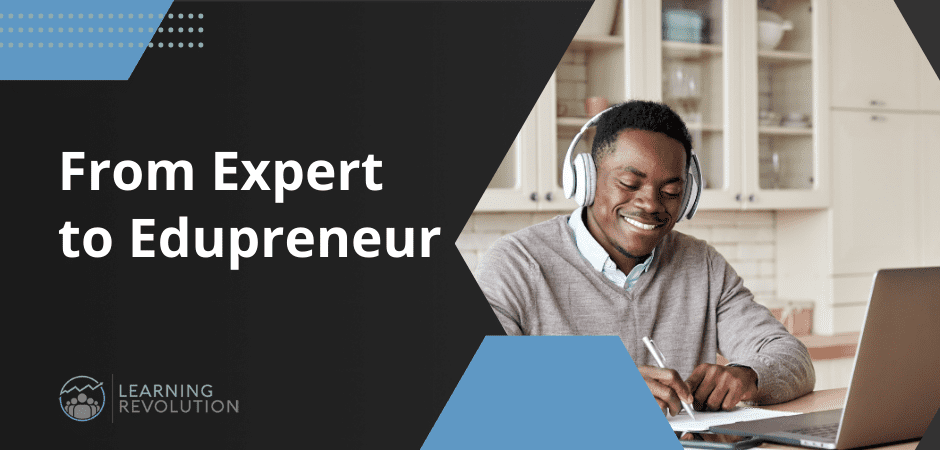
Most of the people who visit the Learning Revolution site come from what we call expertise-based businesses. These are just what they sound like – businesses built around expertise in a particular area of skill or knowledge.
Most often these are small businesses created by a single person or a small team that offers services like consulting and coaching. And, most often, getting access to the expertise they can provide means getting access to the actual experts – in return for payment.
It’s a great model that can support a very nice lifestyle – I know that myself from long personal experience. But it is also a model that has natural limits.
For example, what if you want to reach more people than you or your small team can personally engage with?
What if you would like to generate significantly more revenue than you can by exchanging access (i.e., time) for money?
What if you would like to impact more people and/or impact those you serve more deeply?
Reach. Revenue. Impact.
If increasing one or all of these is your goal, then one of the most direct paths is to move from expert to edupreneur.
And, you’re in luck: that’s exactly what this article is about.
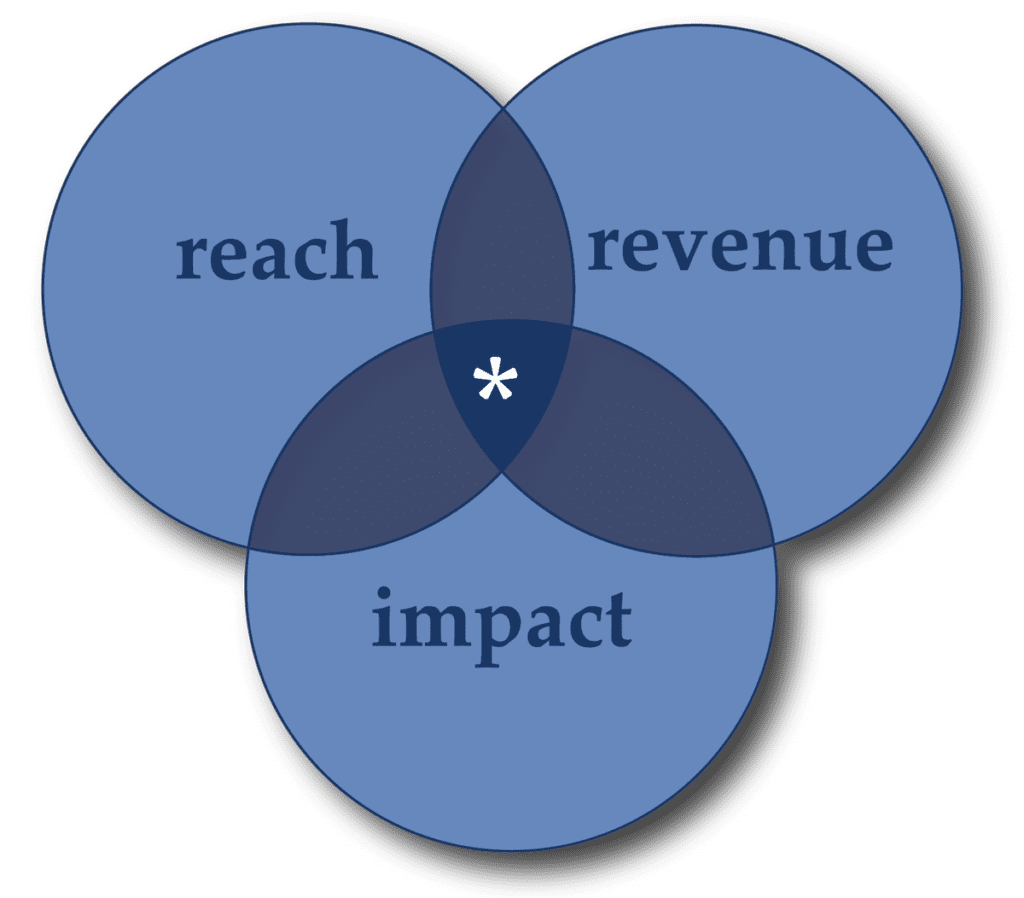
What Is an Edupreneur?
I tackle this question in much more detail in an article I wrote titled – surprise – What Is An Edupreneur. I encourage you to read it, but the short version for purposes of this article is that an edupreneur is someone who combines “entrepreneur” with “educator” to build a business on providing educational content and experiences to people who need them and are willing to pay for them.
The average expert has plenty of content in her and plenty of ability to create learning experiences that will benefit her audience. Becoming an edupreneur is about unlocking this content, amplifying those abilities, and developing your skills as a teacher and facilitator of learning.
Even if you already provide training as part (or all) of your business, becoming truly intentional about being an edupreneur will naturally lead to implementing business models that deliver greater value to more people, make your business much more scalable, and ensure that your business will be sustainable in its own right, regardless of whether you are personally present to play the role of expert.
It’s important to stress that being an edupreneur is also a mindset.
On the surface, it seems straightforward enough to say that expertise can be parlayed into knowledge and education products that people will pay for, but the reality is that many experts struggle to make this shift. It’s tempting to think that your expertise can only be conveyed through personal interaction with you – which necessarily involves you staying closely involved. And it may be difficult to imagine that you can create educational products that people will actually pay for. Moving past these types of limits on your thinking is essential to becoming an edupreneur.
Once you do, the benefits can be enormous.
The Benefits of Being an Edupreneur
The main benefits you gain from moving from expert to edupreneur can be summed up in three words I’ve already used: reach, revenue, and impact. Let’s take a closer look at each.
Greater Reach
Reach is about connecting with more of the people who can benefit from your expertise. Let’s face it, no matter how efficient and streamlined you make your consulting, coaching, or other expertise-based services, there are only so many people you will ever be able to reach and help.
If your model is “do for you” – as is the case with most consultants – you can do quite well by charging premium fees, but beyond a certain point, the only way to scale is to hire people to help you.
If your model is “do with you” – as is the case with most coaches – your ability to scale is quite a bit higher, but still hits a ceiling pretty quickly.
It’s only once you move toward a “do for yourself” model through teaching and facilitating and embrace the highly scalable models that technology has made possible that limitations start to fade away. In theory, you can reach the whole world.
Of course – to be crystal clear – that does not mean the whole world suddenly becomes your market.
Greater reach is also about connecting with the right people, and that’s a key area where the “entrepreneur” part of the equation comes into play. A good entrepreneur is laser focused on identifying the people who will most value what she offers, and these days, the tools and techniques that digital marketing offers make it possible to find those people no matter where they are in the world.
More Reliable Revenue
Reaching more people brings with it the potential for generating more income. While it’s true that you may not be able to charge at the same rate for productized offerings as you can for more personal, customized services, you can still charge appropriately for well-designed offerings and your sales volume and margins have the potential to be dramatically higher.
Keep in mind, too, that as you introduce lower cost options, you can often raise prices on your legacy, higher-touch offerings (which many experts don’t charge enough for in the first place).
In general, your overall revenue potential goes up significantly once you move from the traditional money-for-time approach practiced by most experts to the money-for-value approach favored by successful edupreneurs.
Just as importantly, as you add edupreneurial offerings to your portfolio, you diversify your revenue base, creating much more security and higher sustainability for your business. If consulting or coaching income drops for any reason, you have other income streams to keep you going.
Last – and far from least – if you pursue a membership or subscription model with your offerings, you have the potential for creating recurring revenue – i.e., revenue that continues month-over-month or year-over-year as your customers renew. This leads to much more predictable cashflow that can be used to reinvest in your business, increase your own earnings, and provide much greater peace of mind.
Amplified Impact
Finally, the benefit that I personally find the most compelling: creating more impact with your offerings. This benefit has both a “wide” and “deep” aspect.
The “wide” aspect flows from greater reach. Your expertise will simply have more impact in the world if you are able to reach more people with it. I find that particularly attractive as a consultant who earns very high fees for intensive engagements with a relatively small list of clients who can afford them but would like to help smaller organizations who will never be able to afford my services. (This, for example, is a reason I created the Platform Selection Power Primer.)
The “deep” aspect is based on what we know about how learning and change happen. If we engage with a customer once – for example as a consulting client, a seminar or keynote attendee, a reader of our book – the chances that they will retain and apply what we share with them is relatively low. That’s because learning is a process, not an event. It requires repetition and effort over time.
Even if our current model – as a coach, for example – does extend over time, incorporating educational approaches like course content and assessments or access to a peer learning community can greatly increase the changes that change – and learning is fundamentally about change – will stick. They also provide ways for learners to continue their learning in areas that are specific to their needs and may go well beyond what we typically cover in our more generic coaching, consulting, or training offerings.
Bonus: Sellability
Increased reach, revenue, and impact help make your business more profitable and enjoyable in the here and now but they can also have a substantial impact on your future as a business owner. If some day you may want to sell your business – and actually profit from the sale – you will have a much greater chance of doing it successfully if you have created an edupreneurial business.
It’s simple very hard to sell a business that is largely based on charging for the time and expertise of a single individual or small team. The model isn’t very scalable, the revenue isn’t recurring, and if any or all of the people the business depends upon leave, there really isn’t much of a business left.
Naturally, most buyers of businesses don’t see that as very attractive. Once you have addressed reach, revenue, and impact in the ways described above, though, the business you’ve created will be very attractive to potential buyers.
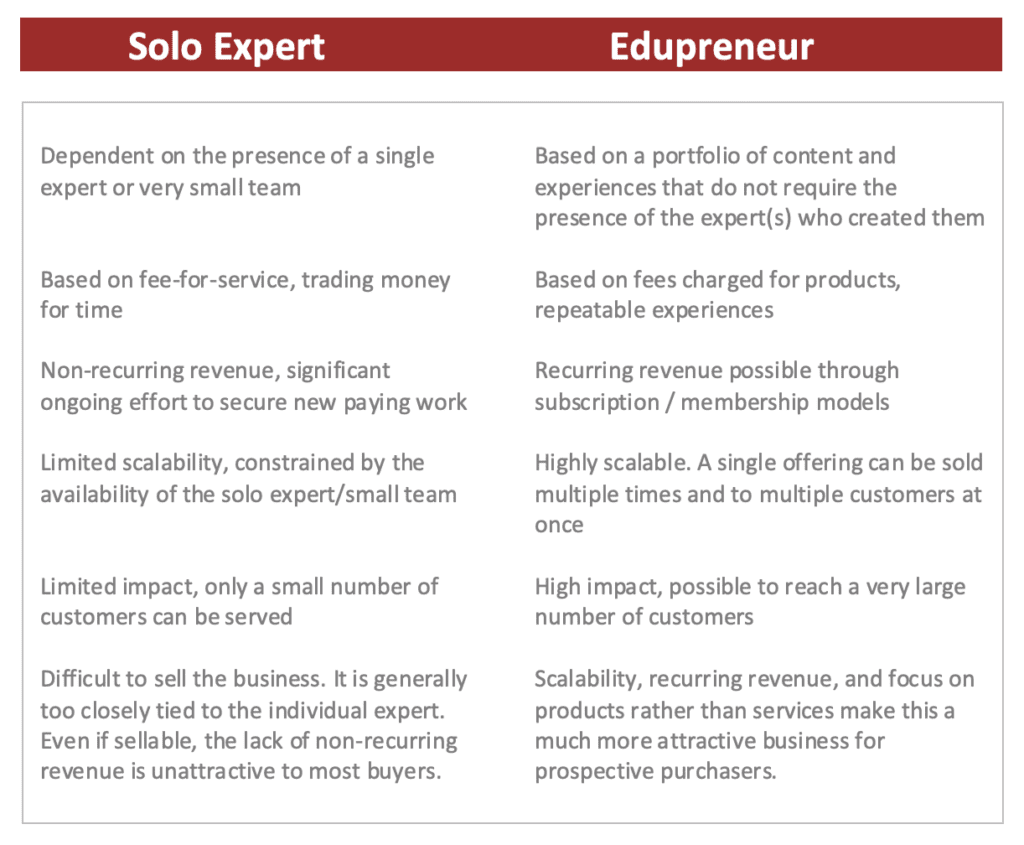
5 Essential Expert-to-Edupreneur Steps
So what does it take to move from expert to edupreneur? Like so many things in life and business, the steps are relatively straightforward and simple but not necessarily easy.
1. Figure out where learning fits
For the purposes of this article, I’m assuming that you already have some knowledge of the key issues your prospective audience faces. These may be perennial – common issues that you’ve heard again and again as you’ve worked with customers over the years as a consultant, coach or trainer. Or they may be emerging – issues that your audience is scrambling to understand. (ChatGPT, for example, is currently creating such issues across most fields and industries.)
If you are not yet at the point of serving customers as an expert – or even if you are – techniques like those covered in 15 Ways to Validate Your Product Ideas can be very helpful here. The article covers four approaches – searching, listening, asking, and testing – that can help you much better understand your audience’s wants and needs and determine outcomes prospective customers may be seeking.
The pivot you need to make as an edupreneur is to identify areas where prospects seem likely to place high value on acquiring new skills, knowledge, or behaviors – in other words, learning – as part of achieving a desired outcome.
If the level of learning required is too difficult or time-consuming, customers are unlikely to pursue it. They would be better off simply hiring you as a consultant or freelancer to do the work for them.
If, on the other hand, it is relatively easy to acquire the necessary skills, knowledge, or behaviors, prospects may simply opt for YouTube, Google, free Webinars, and/or an app. They are unlikely to pay much, if at all, for whatever learning experience you offer. (Of course, this may be an instance in which learning works well as a form of content marketing.)
In general, you are looking for situations where it makes sense for prospective customers to learn and where they are likely to see that it makes sense.
For the average expert, it’s important to realize that one of the most obvious opportunities may be to teach prospects how to do at least some what you do when providing paid services like consulting or coaching. This is the approach I have taken, for example, with my Platform Selection Power Primer.
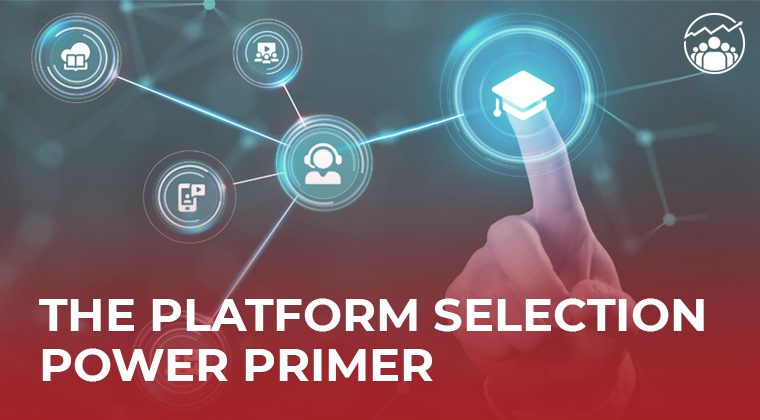
In the Primer, I distill my time-tested process for selecting the right online learning platform down into a couple of hours of course content. Is this the same as engaging me to lead your selection process? Of course not. You don’t get direct access to my experience or customized guidance specific to you and your business. But if you are on a tight budget, simply like to do things yourself, or maybe are trying to get a better feel for my process before deciding to engage me as a consultant, it could be the perfect fit.
2. Determine the right type of learning experience
Once you have identified one or more areas where providing a learning experience clearly has value, you’ll need to determine what type of learning experience makes sense. To figure this out, ask:
- How challenging and complex is the learning required to achieve the desired outcome?
- Is a one-time experience sufficient, or is the need for learning recurring?
The following matrix illustrates how answers to these questions help determine the types of learning experiences you should offer.
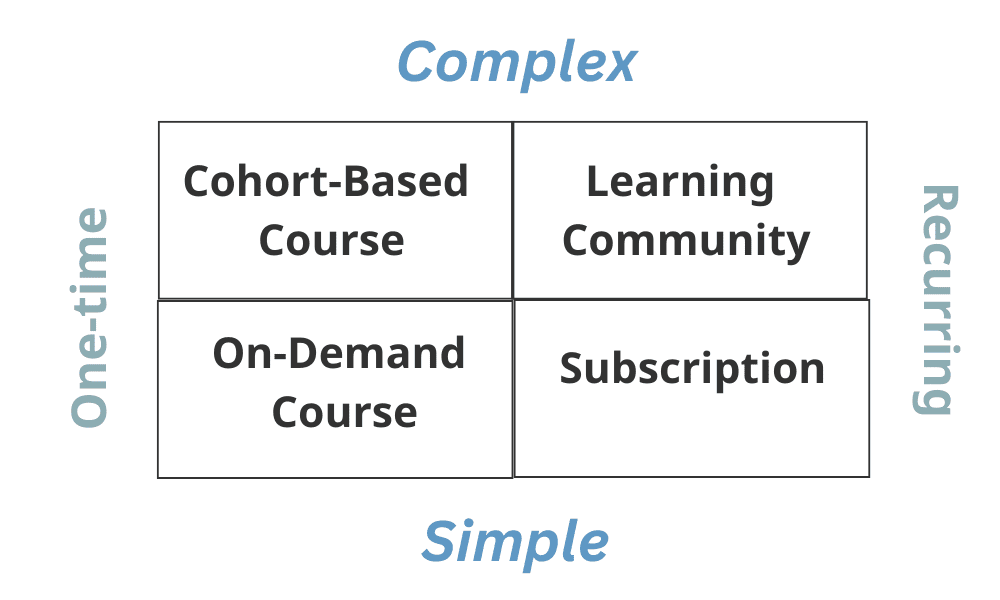
If the learning required to achieve the desired outcome is relatively simple and can usually be accomplished in a single experience, then a traditional self-paced, on-demand course or tutorial may be perfectly sufficient.
If, on the other hand, a single experience is helpful, but learning is much more likely to happen if that experience is extended over time, with opportunities for practice, reflection, and tailored feedback, then a more facilitated approach may be more appropriate. This could include things like periodic live sessions, one-on-one coaching with learners, and/or organizing the experience around cohorts of learners who interact with and support each other throughout the experience. (More on cohort-based learning here.)
Relatively simple experiences that recur over time and involve, for example, acquiring progressively more advanced or detailed knowledge are often a good fit for a subscription model. With a subscription, learners can access content on an as-needed basis over some specified period of time.
Finally, in situations where learning is complex and occurs over time, experiences that involve community – typically mean the ability for learners to interact with each and possibly experts other than yourself – are often the best fit. I discuss learning communities in much more detail here, but in general, a community allows for learning to emerge much more organically in a way that enable individual participants to get their needs met through interaction with the group (as well as with you and any content you may provide).
Over time, you will likely find that you offer multiple types of learning experiences. They key is to always be clear on the outcomes you aim to help your learners achieve with a specific offering and to evaluate what type of learning experiences best support achieving those outcomes.
3. Identify and adapt your assets
Now it’s time to turn to your intellectual property (IP), by which I mean the ideas, concepts, techniques, and tools you have developed in the past as ways of sharing your expertise and/or delivering services to clients. This is the material from which you will build your learning experiences.
In my experience, a lot of experts aiming to make the shift to edupreneur start at this point. They do an inventory – more or less methodically – of the materials they have available, and decide, for example, that a presentation they’ve done before on “concept X” or “method Y” is a good starting point for a course.
But if you haven’t really figured out where learning can provide the most valuable and what type of learning experience has the best chance of delivering the desired outcome, you are likely to create a dud or, at the very least, leave a lot of value – and money – on the table.
So, definitely go through steps one and two first. Once you do, you’ll be able to see quickly which of your existing assets have the highest potential and also where you are going to need to fill in gaps.
“Adapt” means to modify and frame them, as needed, to make them as useful as possible in the learning experience you plan to offer.
In some cases, this may require very little effort. If, for example, you have a chart, checklist, etc., it may be usable as is – as a download within a course, for example – but you’ll need to think through where it fits in the overall design of the learning experience and how you will tee it up when its time comes.
4. Test and tune your offering
If you have done everything above, then you are positioned well for success. Nonetheless, there is no guarantee that you actually have a successful offering on your hands.
To increase your chances of success dramatically, you will need to match up a minimum viable audience (MVA) with a minimum viable product (MVP) and run a pilot. Let’s take a look at each of the components of this step.
Minimum Viable Audience
This is a term I credit to Brian Clark, founder of Copyblogger, Rainmaker, and more recently, Further. The basic idea is that you need to find enough people willing to buy whatever you offer to make it worth your time and effort.
There is no magic number for “enough” – it will depend on factors like how much you plan to charge and what your goals are for introducing the product. It’s one thing if you see the product as the backbone of your business going forward and quite another if you view it as a form of content marketing and/or brand building that also happens to generate some income.
You may have heard about the concept of 1000 raving fans – I refer to it in Leading the Learning Revolution. Certainly, if you have 1000 followers who are passionate about what you do, then the chances you have a minimum viable audience are high. But it’s fine if that’s not where you are. In many cases, a much smaller audience will do the trick – even just a handful of people may give you the toe hold you need to get launched in your market.
That said, once you have your product idea – which will get to in just a second – do be sure to validate in a way that helps you understand whether you have an audience and how to align to that audiences wants and needs.
Minimum Viable Product
As that last sentence may lead you to suspect, it’s a little artificial to separate product and audience, but I do it here just to clarify the two “minimum viable” concepts.
Minimum Viable Product, or MVP, is a term coined by Frank Robinson and popularized by Eric Ries in The Lean Startup. The core idea here is that you shouldn’t put a full, soup-to-nuts version of your offering out into the market initially. Rather, create a version that is likely to satisfy your minimum viable audience.
When it comes to learning experiences, that may mean not obsessing over every detail in your content, holding off on shooting videos or having custom images created, and maybe waiting to decide about investing in an online course platform. There are ways to get your offering out to your audience without the time, effort, and money that perfecting all the pieces requires.
And that leads us to the next element of this step …
Piloting
I’ve written about piloting in detail in another post. But I’ll repeat some of that content here for convenience. This is geared toward courses, but the same principles apply to launching a membership offering, podcast, live streaming series, or any of the other options for monetizing your expertise.
- Outline the basic structure of your offering – for a course, this could be your curriculum; for a community, it might be the types of interactions you will offering – e.g., periodic live sessions, discussion boards devoted to specific topics.
- Pull together your basic tools for promoting – e.g. – a series of 3-5 emails conveying the value of the offering, a decent sales page to point people to.
- Begin promoting to your minimum viable audience. (You don’t have to have a huge audience at this point – just enough to get somewhere between 10 and 25 people into a pilot. (As discussed more below, you should always be working on building your audience.)
- Simultaneously, pull together any materials you may need for the pilot – e.g., slides, worksheets. Keep it very simple – go for “minimum effective dose.”
- For delivery, keep your technology minimal. Use a live platform like Zoom or Webinar Ninja. Yes, this will be a live pilot – that part is essential. You want to be able to interact with your learners, change things on the fly, etc. And you don’t want the stress of committing your materials to a fixed, semi-permanent format.
- Run the pilot course over a period of days or weeks – whatever is appropriate for the type of learning experience you plan to offer.
- Collect feedback from students both during and after the pilot and use this to adjust along the way and for planning for your productized course.
- Collect testimonials from students – this will be invaluable in marketing your productized course.
- Assuming the majority of the feedback is enthusiastically favorable, and you can address any significant issues, proceed to creating the full product. At this point, you may want to consider taking your technology to the next level – e.g., one of the many online course platforms available for selling online courses.
If the feedback is not what you were hoping for, or you encounter challenges that you need to work through, run a second pilot to test out changes. Repeat (within reason) until you have it nailed. Alternatively, you may discover that you just don’t have a sellable offering and it’s time to try a different idea.
In general, the whole process of testing and tuning will take some time and may make you feel frustrated at points but working through it is probably the single most valuable thing you can do for your business. You’ll learn a ton about who your best audience really is and what they really want.
5. Invest in continuous platform building
Once you have gone through steps 1-4, you are on the path to building a much more scalable, sustainable business. To keep moving along that path toward true success, though, you are going to need to invest intentionally and systematically in building your platform.
I mean platform here in a very broad sense. It includes whatever technologies you may use, but it also includes the people and systems that enable you to multiply and scale your impact. And, most of all, it involves building your presence and your brand with the audience you aim to serve. In a sense, you are aiming for something is like a political platform – an approach that combines what you are known for and promise to achieve for those who follow you with the machine to make it happen.
Take careful note that technology is only part of what makes up a successful platform. And, really, it’s not even close to the most important part. I say that because I am so often contacted by people who are stressed out about choosing the right technology platform. While I definitely think that choosing the right platform is important (I’ve even created a course on it), I also think it is pretty straightforward.
Somewhat harder – though also pretty straightforward – is getting intentional and disciplined about putting clear processes in place for using your technology well and executing effectively on all of the key activities that comprise your business. (I’ve noted before that the best internet marketers are masters at this.)
Often less straightforward – and the part that deserves the most attention – is the process of forging connections that preserve and amplify who you are and how you deliver value. These are connections with your prospects and customers but also with any influencers, partners, contractors, and others who help you create or sell your offerings. Don’t leave this to chance. Think about and plan how you will systematically identify and engage with these people over time.
Starting the Expert to Edupreneur Journey

As you may already realize, everything I describe above doesn’t happen overnight.
There is a lot of “get rich quick” noise (and even scams) out there right now in the world of online courses, membership sites, and other types of learning products, but as with any other line of business, being a successful edupreneur is rarely a “get rich quick” pursuit. You must do the work and it takes time.
If connecting with people at scale, helping them achieve learning goals that could change their lives, increasing your income, and creating a sellable business in the process sounds attractive, then the next step is clear: get started.
Head back up to step number one above and start figuring out where learning fits in your relationship with your prospects and customers. As you continue through the steps, I encourage you to return to Learning Revolution as a resource – and consider subscribing to our e-mail updates. Being an edupreneur has both its short-term and its long-term challenges. We’re here to help.
See you at the Revolution.
JTC
Table of Contents

Related Posts
A Creator’s Guide to Understanding the YouTube Super Chat Feature
Thinkific Funnels: A Guide to Boosting Your Business Revenue with Sales Funnels
From Course Creator to Digital Empire: Inside Kajabi’s Bold Transformation